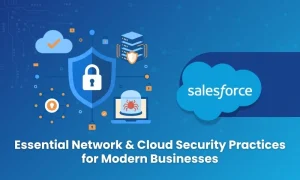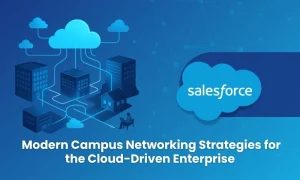As businesses shift to cloud-centric, data-driven, and AI-powered environments, traditional legacy systems often fall short. A greenfield network deployment provides a strategic opportunity to build a future-proof infrastructure free from legacy constraints.
Unlike brownfield projects, which upgrade existing networks, greenfield deployments allow for the design and implementation of cutting-edge technologies tailored to modern needs. This approach enables businesses to optimize performance, reduce operational complexity, and ensure scalability.
For businesses adopting innovations like private 5G networks, SD-WAN, and cloud-native technologies, a greenfield strategy is essential. It unlocks superior network performance, efficiency, and security, enabling enterprises to maintain a competitive edge in a digital-first world.
The Strategic Imperative for Enterprises
As enterprises continue their digital transformation journeys, the importance of building adaptable, high-performance networks has never been more critical.
A greenfield network deployment offers the opportunity to build a modern, efficient infrastructure that meets the increasing demands of new technologies. Let’s explore why greenfield deployments are becoming a strategic imperative for enterprises:
Performance, Flexibility, and Scalability
A major benefit of greenfield network deployments is the inherent ability to design for optimal performance from the start. Traditional networks often struggle with bottlenecks, high latency, and scalability issues, especially when integrating new technologies.
Greenfield deployments enable enterprises to build high-bandwidth networks capable of supporting modern demands like AI/ML, IoT, cloud-native applications, and edge computing.
Specifically, this approach allows businesses to implement the latest optical fiber technologies, advanced SD-WAN configurations, and private 5G infrastructures that can handle growing data demands.
Free from outdated constraints, companies can deploy 100Gb/s+ connections, engineer for low-latency applications, and ensure their networks are future-proofed for long-term scalability.
Business Drivers
Several key factors are driving enterprises toward greenfield network deployments:
Cloud Migration & Digital Transformation: As businesses move to the cloud, greenfield deployments offer the flexibility to design networks that optimize cloud connectivity and support cloud-native services.
Edge Computing & IoT: These technologies require low-latency, high-throughput connections. Greenfield networks are designed to meet these demands without the limitations of legacy infrastructure.
Private 5G Networks: With the rise of private 5G, greenfield deployments allow enterprises to create secure, high-performance networks tailored to their specific needs, such as ultra-low latency and IoT support.
Security by Design: Greenfield networks enable the integration of robust security measures, such as zero-trust and SASE, from the ground up, ensuring better protection from the start.
Agility & Innovation: Building a greenfield network from scratch allows enterprises to quickly adopt new technologies and scale as business needs evolve, supporting faster time-to-market for new services.
Quantifying the ROI/TCO of Greenfield Deployments
Greenfield deployments offer a clear path to significant long-term value, despite higher initial costs. Here’s how to quantify the ROI and TCO:
CapEx vs OpEx: While greenfield deployments require a larger initial investment (CapEx), they offer lower operational costs (OpEx) in the long run due to simplified management, reduced maintenance, and fewer upgrades compared to brownfield projects.
Speed to Market & Risk Reduction: Greenfield networks are quicker to deploy since there are no legacy systems to upgrade, enabling faster rollout of cloud services, SD-WAN, or private 5G. This reduces business risk associated with outdated systems and delays.
Illustrative Financial Model
Let’s look at a simplified financial model comparing the costs and ROI of a greenfield SD-WAN deployment versus a traditional brownfield MPLS upgrade. Assume a 100-site enterprise considering a network overhaul.
- Current State (Brownfield):
- Annual MPLS costs: $3 million
- Network upgrades (hardware, additional bandwidth): $200,000/year
- Total annual operational cost: $3.2 million
- Greenfield SD-WAN Deployment:
- CapEx: $1 million (for hardware, SD-WAN software, network gear)
- OpEx savings: $0.9 million/year (due to reduced MPLS costs, better bandwidth optimization)
- Payback period: 1.1 years
- ROI after 3 years: 120% (based on total cost savings and performance improvements)
This financial model highlights how greenfield deployments deliver value by reducing operational costs and offering a quicker return on investment.
Greenfield vs Brownfield: Key Differences
| Dimension | Greenfield | Brownfield |
| Design Freedom | Full freedom to design with modern technologies. | Constrained by existing infrastructure, limited flexibility. |
| Technology Freshness | Built with the latest technologies (e.g., 100Gb/s+ connectivity, private 5G). | Often limited by legacy equipment and outdated technologies. |
| Initial Cost (CapEx) | A higher initial investment is required to build from scratch. | Lower upfront costs due to leveraging existing infrastructure. |
| Operational Costs (OpEx) | Lower ongoing costs due to reduced maintenance and simplified operations. | Higher operational costs due to ongoing upgrades, maintenance, and integrations. |
| Performance | High performance, designed for modern applications like AI/ML, cloud, and IoT. | May struggle with bottlenecks and latency issues, especially with outdated systems. |
| Scalability | Easy scalability to support future growth and emerging technologies. | Limited scalability, often requiring significant upgrades to accommodate growth. |
| Speed to Market | Faster to deploy new solutions without legacy constraints. | Slower deployment as it involves retrofitting and integrating with old systems. |
| Risk Profile | Higher initial risk in terms of investment and design. | Lower immediate risk but potential for unexpected issues during upgrades or migrations. |
| Future-Proofing | Built with future technologies in mind, offering greater long-term flexibility. | May require costly upgrades or replacements to meet future demands. |
| Adaptability to Emerging Tech | Highly adaptable to new tech such as AI, 5G, and edge computing. | May require major overhauls to support new technologies or innovations. |
Challenges in Greenfield Deployments
| Challenge | Description |
| Upfront Costs and Risk Management | Greenfield deployments require substantial CapEx for initial setup (hardware, infrastructure, licenses). This can be a significant financial burden, though long-term OpEx savings often offset the initial investment. Risk can be mitigated through thorough cost-benefit analyses and phased rollouts. |
| Technical Debt and Future-Proofing | Overestimating future requirements can lead to overbuilding, wasting resources. Conversely, underbuilding can result in an infrastructure that doesn’t scale adequately. Careful planning and forecasting are necessary to avoid these issues and ensure the network remains adaptable to future needs. |
| Vendor and Integration Risks | Selecting the right vendors and ensuring seamless integration with other business systems (cloud, legacy, security) is crucial. Misalignment with vendor solutions or integration failures can delay deployments and increase costs. |
| Regulatory and Compliance Challenges | Industries such as healthcare, finance, and government must ensure that new networks meet regulatory requirements (HIPAA, GDPR, PCI-DSS, etc.). Failing to design with compliance in mind could lead to legal issues or security gaps. |
| Project Management Complexity | The complexity of managing a greenfield deployment from end to end requires expert project management, involving multiple teams, timelines, and integration points. Poor management can lead to delays, budget overruns, or underperformance. |
| Change Management | Transitioning to a greenfield network requires a well-structured change management plan to minimize disruptions. Employees must be trained on new systems and processes, and existing workflows may need to be adjusted to accommodate the new network. |
| Skill Gaps and Knowledge | Building a greenfield network involves cutting-edge technologies that may require specialized skills. Enterprises may face a skills gap, requiring them to either upskill existing IT staff or hire external experts. This can lead to training costs and extended timelines. |
A Checklist for Executing a Greenfield Network Deployment
To help CIOs, CTOs, and network architects streamline their decision-making and deployment processes, here’s a comprehensive checklist to guide your greenfield network strategy.
1. Define Business Outcomes and Use Cases
- Identify key objectives: Clearly define the goals of the network deployment (e.g., improved performance, scalability, cost reduction, future-proofing).
- Evaluate use cases: Align the network design with emerging business needs, such as cloud-native applications, AI/ML workloads, edge computing, or private 5G.
- Consider business continuity: Ensure the network design supports critical business applications and offers high availability and disaster recovery options.
2. Baseline Current Network State and Quantify Cost of Inaction
- Assess current infrastructure: Understand the limitations of your existing network (e.g., performance bottlenecks, security vulnerabilities, scaling issues).
- Calculate the cost of inaction: Estimate the long-term costs of maintaining legacy infrastructure, including higher operational expenses, increased risk, and missed opportunities for digital transformation.
3. Choose a Scalable, Future-Proof Architecture
- Growth plan: Design a network that can easily scale to meet future demands. Consider technologies like 100Gb/s+ fiber, SD-WAN, and private 5G to support data-heavy applications and a growing number of connected devices.
- Ensure flexibility: Ensure the network can integrate with emerging technologies and accommodate future changes, such as AI, IoT, or new cloud services.
4. Integrate Security by Design
- Zero-Trust Architecture: Implement zero-trust security protocols to ensure strict identity verification and network access controls.
- SASE/SSE: Consider SASE (Secure Access Service Edge) or SSE (Security Service Edge) to secure edge devices and cloud applications.
- Data encryption: Ensure end-to-end data encryption is built into the network architecture to protect sensitive information.
5. Model Financials with CapEx and OpEx Projections
- CapEx: Define the initial investment required for hardware, infrastructure, and software deployment.
- OpEx: Estimate the long-term operational costs, including network management, monitoring, and maintenance.
- ROI & Payback: Create a financial model to determine the expected ROI, payback period, and potential cost savings over the long term (using benchmarks from previous sections).
6. Implement Automation and Policy-Driven Network Operations
- Network Automation: Implement network management tools that support automation, such as software-defined networking (SDN) and network function virtualization (NFV).
- Policy-driven management: Use policy-based management to ensure consistent security, performance, and compliance across all network segments.
7. Monitor, Measure, and Optimize Performance
- Continuous monitoring: Set up real-time monitoring for network performance, bandwidth usage, latency, and security threats.
- Performance optimization: Regularly optimize the network to ensure it meets business objectives and user expectations.
8. Governance, Change Management, and Skill Development
- Establish governance: Set up governance frameworks to ensure compliance, data privacy, and security standards are maintained.
- Manage change: Develop a change management plan to guide the transition to the new network and minimize disruptions to ongoing operations.
- Skills development: Ensure that network engineers and IT staff are trained to manage and maintain the new infrastructure effectively.
9. Prepare for Emerging Technologies and Future Expansion
- Stay ahead of the curve: Design the network with flexibility to integrate emerging technologies such as AI/ML, edge computing, 5G, and quantum networking.
- Cloud and hybrid readiness: Ensure the network can support future expansions into hybrid or multi-cloud environments.
10. Engage with Trusted Vendors and Partners
- Vendor selection: Choose reliable vendors and partners with proven experience in delivering greenfield network solutions.
- Long-term relationships: Establish partnerships with vendors that offer ongoing support, scalability options, and the flexibility to adapt to future technological needs.
Conclusion
As digital transformation accelerates, enterprises need modern, scalable, and secure networks. Greenfield network deployments provide a strategic opportunity to build future-proof infrastructure for cloud, edge computing, AI/ML, and private 5G.
With careful planning, greenfield deployments offer significant cost savings, improved performance, and a competitive edge. While the upfront investment may be higher, the long-term ROI and TCO savings make it a smart choice for forward-thinking organizations.
SyncingSoft specializes in Green Field Network Deployment & Strategy, helping enterprises design, implement, and scale networks that drive business success. Contact us today to learn how we can help power your future.







